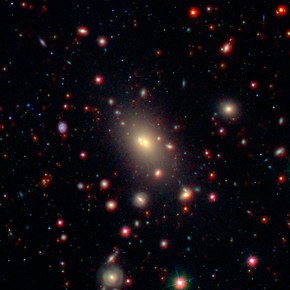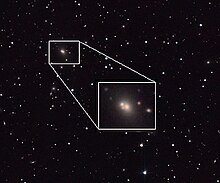| NGC 6166 | |
|---|---|
 NGC 6166 by Spitzer Space Telescope NGC 6166 by Spitzer Space Telescope | |
| Observation data (J2000 epoch) | |
| Constellation | Hercules |
| Right ascension | 16 28 38.276 |
| Declination | +39° 33′ 04.97″ |
| Redshift | z = −0.030354 (minus sign indicates blueshift) |
| Heliocentric radial velocity | −9100 km/s |
| Distance | 490 Mly (142 Mpc) |
| Apparent magnitude (V) | 12.78 |
| Absolute magnitude (V) | −24.1 |
| Characteristics | |
| Type | cD2 pec. |
| Apparent size (V) | 1.9’ x 1.4’ |
| Other designations | |
| UGC 10409, PGC 58265, CGCG 2205.6+3107 0504, MCG +07-34-060, 3C 338 | |

NGC 6166 is an elliptical galaxy in the Abell 2199 cluster. It lies 490 million light years away in the constellation Hercules. The primary galaxy in the cluster, it is one of the most luminous galaxies known in terms of X-ray emissions.
Description
NGC 6166 is a supermassive, type cD galaxy, with several smaller galaxies within its envelope.
Suspected to have formed through a number of galaxy collisions, NGC 6166 has a large number of globular clusters (estimated as between 6,200 and 22,000 in 1996) orbiting the galaxy. A 2016 study, however, gave an even higher number (around 39,000) suggesting also that the halo of this galaxy blends smoothly with the intra-cluster medium. Because of that, the galaxy has the richest globular cluster system known. The galaxy harbors a supermassive black hole at its center with a mass of nearly 30 billion M☉ based on dynamical modelling.
NGC 6166 is known to host an active nucleus, classified as an FR I source, which powers two symmetric parsec-scale radio jets and radio lobes. These are caused by the infall of gas into its center due to a cooling flow that deposits 200 solar masses of gas every year there.
It has been proposed that a number of O-type stars may be present in the center of NGC 6166.
-
 Close-up of galaxy NGC 6166, by HST (ACS, WFPC2).
Close-up of galaxy NGC 6166, by HST (ACS, WFPC2).
-
 Dust lanes at Galaxy NGC 6166 core, by HST (ACS, WFPC2).
Dust lanes at Galaxy NGC 6166 core, by HST (ACS, WFPC2).
See also
References
- "SIMBAD query result".
- ^ Bridges, T.J.; Cater, D (April 26, 1996). "B-R Colors of Globular Clusters in NGC 6166 (A2199)". The Astrophysical Journal. 281 (4): 1290–1296. arXiv:astro-ph/9604159v1. Bibcode:1996MNRAS.281.1290B. doi:10.1093/mnras/281.4.1290. S2CID 119458738.
- Notes for object NGC 6166 (NED)
- Pritchet, C. J.; Harris, William E. (1990). "A globular cluster system surrounding the cD galaxy NGC 6166". The Astrophysical Journal. 355: 410. Bibcode:1990ApJ...355..410P. doi:10.1086/168774.
- Harris, William E.; Blakeslee, John P.; Whitmore, Bradley C.; Gnedin, Oleg Y.; Geisler, Douglas; Rothberg, Barry (2016). "Globular Cluster Systems in Brightest Cluster Galaxies. II. NGC 6166". The Astrophysical Journal. 817 (1): 17pp. arXiv:1511.08493. Bibcode:2016ApJ...817...58H. doi:10.3847/0004-637X/817/1/58. S2CID 118501801.
- Magorrian, J.; Tremaine, S.; Richstone, D.; Bender, R.; Bower, G.; Dressler, A.; Faber, S.~M.; Gebhardt, K.; Green, R.; Grillmair, C.; Kormendy, J.; Lauer, T. (June 1998). "The Demography of Massive Dark Objects in Galaxy Centers". The Astronomical Journal. 115 (6): 2285–2305. arXiv:astro-ph/9708072. Bibcode:1998AJ....115.2285M. doi:10.1086/300353. S2CID 17256372.
- Di Matteo, Tiziana; Johnstone, Roderick M (March 8, 2001). "Accretion onto Nearby Supermassive Black Holes: Chandra Constraints on the Dominant Cluster Galaxy NGC 6166". The Astrophysical Journal. 550 (1): L19. arXiv:astro-ph/0012194. Bibcode:2001ApJ...550L..19D. doi:10.1086/319489. S2CID 15581216.
- Fisher, David; Illingworth, Garth; Franx, Marijn (1995). "Kinematics of 13 brightest cluster galaxies". The Astrophysical Journal Letters. 438 (2): 539–562. Bibcode:1995ApJ...438..539F. doi:10.1086/175100.
- Bertola, F.; Gregg, M. D.; Gunn, J. E.; Oemler, A., Jr. (1986-04-01). "The Stellar Population of NGC 6166". The Astrophysical Journal. 303: 624. Bibcode:1986ApJ...303..624B. doi:10.1086/164111. ISSN 0004-637X.
{{cite journal}}: CS1 maint: multiple names: authors list (link)
External links
 Media related to NGC 6166 at Wikimedia Commons
Media related to NGC 6166 at Wikimedia Commons
| Constellation of Hercules | |||||||||||||
|---|---|---|---|---|---|---|---|---|---|---|---|---|---|
| Stars |
| ||||||||||||
| |||||||||||||
| |||||||||||||
| |||||||||||||
| Galaxies |
| ||||||||||||
| |||||||||||||
| |||||||||||||
This elliptical galaxy article is a stub. You can help Misplaced Pages by expanding it. |